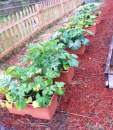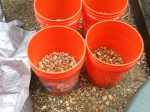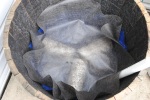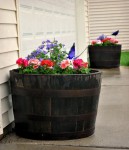 It’s Spring and we’ve got the planting bug. Flowers, trees, vegetables and herbs are flying off the shelves of the local big box stores and nurseries. Loads of people who want to get involved, don’t do so because of space constraints. I totally get it, because my wife and I are living in a second floor apartment with no garden space. I’m going to devote the next few paragraphs with some ideas on how to get around space problems. I’m also going to suggest how this will help you deal with a tyrannical Home Owners Association that refuses to allow gardens, even in the back yard of your property.
It’s Spring and we’ve got the planting bug. Flowers, trees, vegetables and herbs are flying off the shelves of the local big box stores and nurseries. Loads of people who want to get involved, don’t do so because of space constraints. I totally get it, because my wife and I are living in a second floor apartment with no garden space. I’m going to devote the next few paragraphs with some ideas on how to get around space problems. I’m also going to suggest how this will help you deal with a tyrannical Home Owners Association that refuses to allow gardens, even in the back yard of your property.
The short answer to all the issues mentioned above is, container growing. Even if you’ve only got a tiny space, or if you’ve got HOA Nazi’s watching your every move, containers can save you.
First, they come in all shapes, sizes, and colors. You can arrange them all sorts of creative ways, mixing flowers, trees, and bushes with edibles, in eye appealing arrangements that will satisfy nearly everyone in your neighborhood.
You can have anything from bags, to the fanciest ornamental pots. And anything you can grow in the ground, will grow in a container. It’s just that the care is a bit different. You may have to fertilize and water more, and you may have to spend a little time in pruning and shaping some things.
I’ve even grown apple and citrus trees in containers. I chose the varieties carefully, from a catalogue, rather than a big box garden center, but they were gorgeous. I just remembered, I’ve grown pear trees and pineapple plants in containers, too.
This year, everything is going in containers, Potatoes, tomatoes, peppers, squash, lettuce, the whole garden. And to be fair, I’m having to use three properties; a friend’s greenhouse, the space around the outside of our apartment building, and the back path at our Church. But the thing is, I really want a garden, so I’m willing to do whatever I need to do to make it happen.
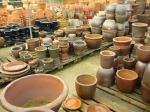 Many edible plants, like herbs and greens look very nice growing in pots. But so do squash plants. They have big beautiful flowers that attract bees and butterflies. If you stake them well, they are gorgeous. And so are beans, especially lima beans and scarlet runners. Take your time and look through seed and plant catalogues for attractive flowers and fruit. If tomatoes, peppers and even eggplant are displayed properly, and the correct varieties are chosen, they can be real eye poppers.
Many edible plants, like herbs and greens look very nice growing in pots. But so do squash plants. They have big beautiful flowers that attract bees and butterflies. If you stake them well, they are gorgeous. And so are beans, especially lima beans and scarlet runners. Take your time and look through seed and plant catalogues for attractive flowers and fruit. If tomatoes, peppers and even eggplant are displayed properly, and the correct varieties are chosen, they can be real eye poppers.
I don’t think there are any herbs that are not spectacular when grown in a container. All you need to do, is search the catalogues, and maybe the internet for ideas on placement and how to display them.
If you have any questions, suggestions, or ideas, drop me a note either in the contact us section of the website, or via email. Don’t let space limitations, or closed minded people, get you down. It’s Spring. Let your creativity fly.
